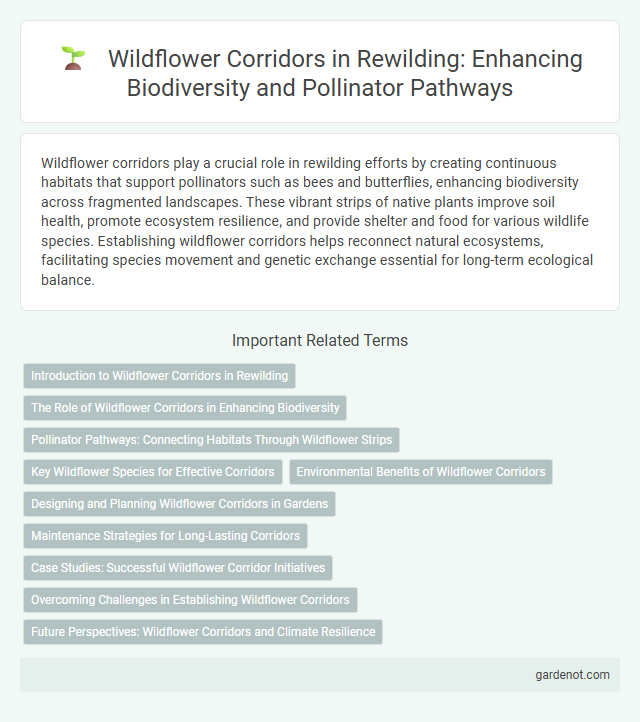Wildflower corridors play a crucial role in rewilding efforts by creating continuous habitats that support pollinators such as bees and butterflies, enhancing biodiversity across fragmented landscapes. These vibrant strips of native plants improve soil health, promote ecosystem resilience, and provide shelter and food for various wildlife species. Establishing wildflower corridors helps reconnect natural ecosystems, facilitating species movement and genetic exchange essential for long-term ecological balance.
Introduction to Wildflower Corridors in Rewilding
Wildflower corridors in rewilding projects serve as vital ecological networks that support biodiversity by connecting fragmented habitats and providing continuous resources for pollinators, birds, and other wildlife. These corridors enhance soil health, promote native plant growth, and facilitate species migration, helping ecosystems regain natural balance. Implementing wildflower corridors contributes significantly to restoring ecosystem services and increasing landscape resilience in rewilded areas.
The Role of Wildflower Corridors in Enhancing Biodiversity
Wildflower corridors serve as vital ecological networks that support pollinators such as bees, butterflies, and other insects by providing continuous habitats rich in nectar and pollen. These corridors facilitate gene flow between isolated plant populations, enhancing overall genetic diversity and resilience in native flora. By linking fragmented habitats, wildflower corridors contribute to increased biodiversity, ecosystem stability, and the restoration of natural processes in rewilding landscapes.
Pollinator Pathways: Connecting Habitats Through Wildflower Strips
Wildflower corridors serve as vital pollinator pathways by linking fragmented habitats and providing continuous resources for bees, butterflies, and other pollinating insects. These strips of native wildflowers enhance biodiversity, promote gene flow among plant populations, and support ecosystem resilience. Implementing wildflower corridors boosts pollination services crucial for agricultural productivity and natural habitat restoration.
Key Wildflower Species for Effective Corridors
Key wildflower species for effective wildflower corridors include native perennials such as Echinacea purpurea (purple coneflower), Asclepias tuberosa (butterfly milkweed), and Rudbeckia hirta (black-eyed Susan), which support pollinators and enhance biodiversity. These species provide essential nectar and habitat for bees, butterflies, and other beneficial insects, promoting ecological resilience. Incorporating diverse wildflowers with staggered blooming periods ensures continuous forage and maximizes the corridor's environmental benefits.
Environmental Benefits of Wildflower Corridors
Wildflower corridors enhance biodiversity by providing vital habitats and food sources for pollinators such as bees and butterflies. These corridors improve soil health through natural nitrogen fixation and prevent erosion by stabilizing the ground with diverse root systems. They also contribute to carbon sequestration, helping mitigate climate change effects in rewilded landscapes.
Designing and Planning Wildflower Corridors in Gardens
Designing and planning wildflower corridors in gardens involves selecting native plant species that support local pollinators and enhance biodiversity. Strategic placement along pathways and edges maximizes ecological connectivity and facilitates wildlife movement. Incorporating diverse flowering periods ensures continuous resources for insects throughout the growing season.
Maintenance Strategies for Long-Lasting Corridors
Wildflower corridors require regular maintenance strategies such as periodic mowing, invasive species control, and strategic planting to ensure biodiversity and habitat connectivity. Implementing seasonal monitoring helps identify areas needing intervention, while adaptive management supports resilience against climate fluctuations. Soil health management, including organic mulching and minimal chemical use, promotes sustainable growth and long-lasting ecological benefits.
Case Studies: Successful Wildflower Corridor Initiatives
The High Line in New York City demonstrates how urban wildflower corridors transform neglected spaces into vibrant ecosystems supporting pollinators and native wildlife. In the UK, the Buglife Wildflower Corridor project successfully restored 12 kilometers of roadside verges, significantly increasing biodiversity and insect populations. Germany's Wildflower Highway initiative showcases extensive collaboration between local governments and conservation groups to reintroduce native wildflowers, enhancing ecological connectivity across fragmented landscapes.
Overcoming Challenges in Establishing Wildflower Corridors
Establishing wildflower corridors requires addressing challenges such as soil degradation, invasive species control, and inconsistent pollinator presence. Implementing native plant selection and adaptive management strategies enhances corridor resilience and biodiversity. Collaboration with local landowners and restoration experts accelerates habitat connectivity and ecological restoration.
Future Perspectives: Wildflower Corridors and Climate Resilience
Wildflower corridors enhance climate resilience by supporting pollinator populations and improving ecosystem connectivity, which facilitates species migration in response to changing temperatures. These corridors increase biodiversity and soil stability, mitigating the impacts of extreme weather events such as droughts and floods. Future perspectives emphasize integrating wildflower corridors into urban and agricultural landscapes to create adaptive, climate-resilient ecosystems.
Wildflower corridor Infographic

 gardenot.com
gardenot.com